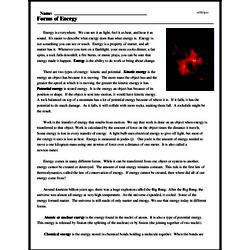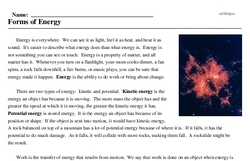Forms of Energy
Energy is everywhere. We can see it as light, feel it as heat, and hear it as sound. It's easier to describe what energy does than what energy is. Energy is not something you can see or touch. Energy is a property of matter, and all matter has it. Whenever you turn on a flashlight, your mom cooks dinner, a fan spins, a rock falls downhill, a fire burns, or music plays, you can be sure that energy made it happen. Energy is the ability to do work or bring about change.
There are two types of energy: kinetic and potential. Kinetic energy is the energy an object has because it is moving. The more mass the object has and the greater the speed at which it is moving, the greater the kinetic energy it has. Potential energy is stored energy. It is the energy an object has because of its position or shape. If the object is sent into motion, it would have kinetic energy. A rock balanced on top of a mountain has a lot of potential energy because of where it is. If it falls, it has the potential to do much damage. As it falls, it will collide with more rocks, making them fall. A rockslide might be the result.
Work is the transfer of energy that results from motion. We say that work is done on an object when energy is transferred to that object. Work is calculated by the amount of force on the object times the distance it travels. Some energy is lost in every transfer of energy. A light bulb uses electrical energy to give off light, but most of the energy it uses is lost as heat. Energy is measured in joules (j). One joule is the amount of energy needed to move a one kilogram mass using one newton of force over a distance of one meter. It is also called a newton-meter.
Energy comes in many different forms. While it can be transferred from one object or system to another, energy cannot be created or destroyed. The amount of total energy remains constant. This rule is the first law of thermodynamics, called the law of conservation of energy. If energy cannot be created, then where did all of our energy come from?
Around fourteen billion years ago, there was a huge explosion called the Big Bang. After the Big Bang, the universe was almost all energy at very high temperature. As the universe expanded, it cooled. Some of the energy formed matter. The universe is still made of only matter and energy. We use that energy today in different forms.




